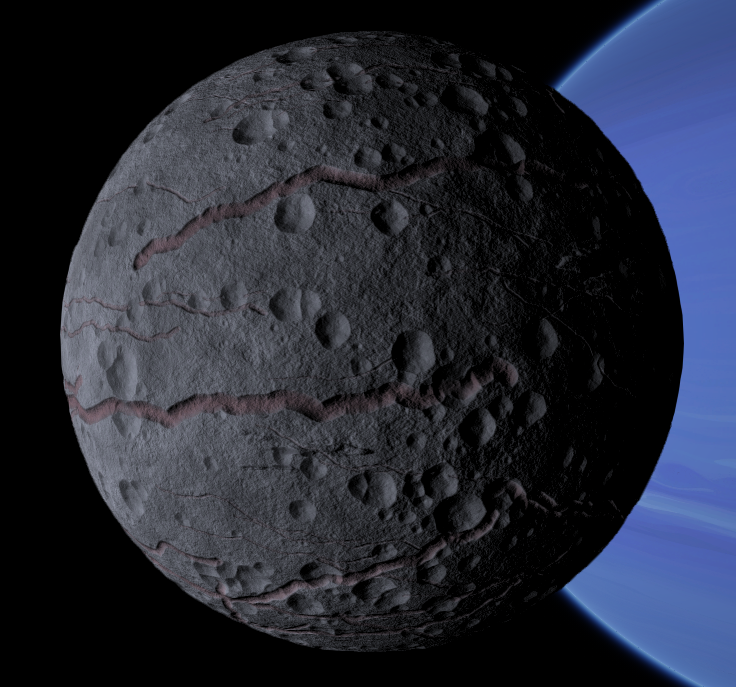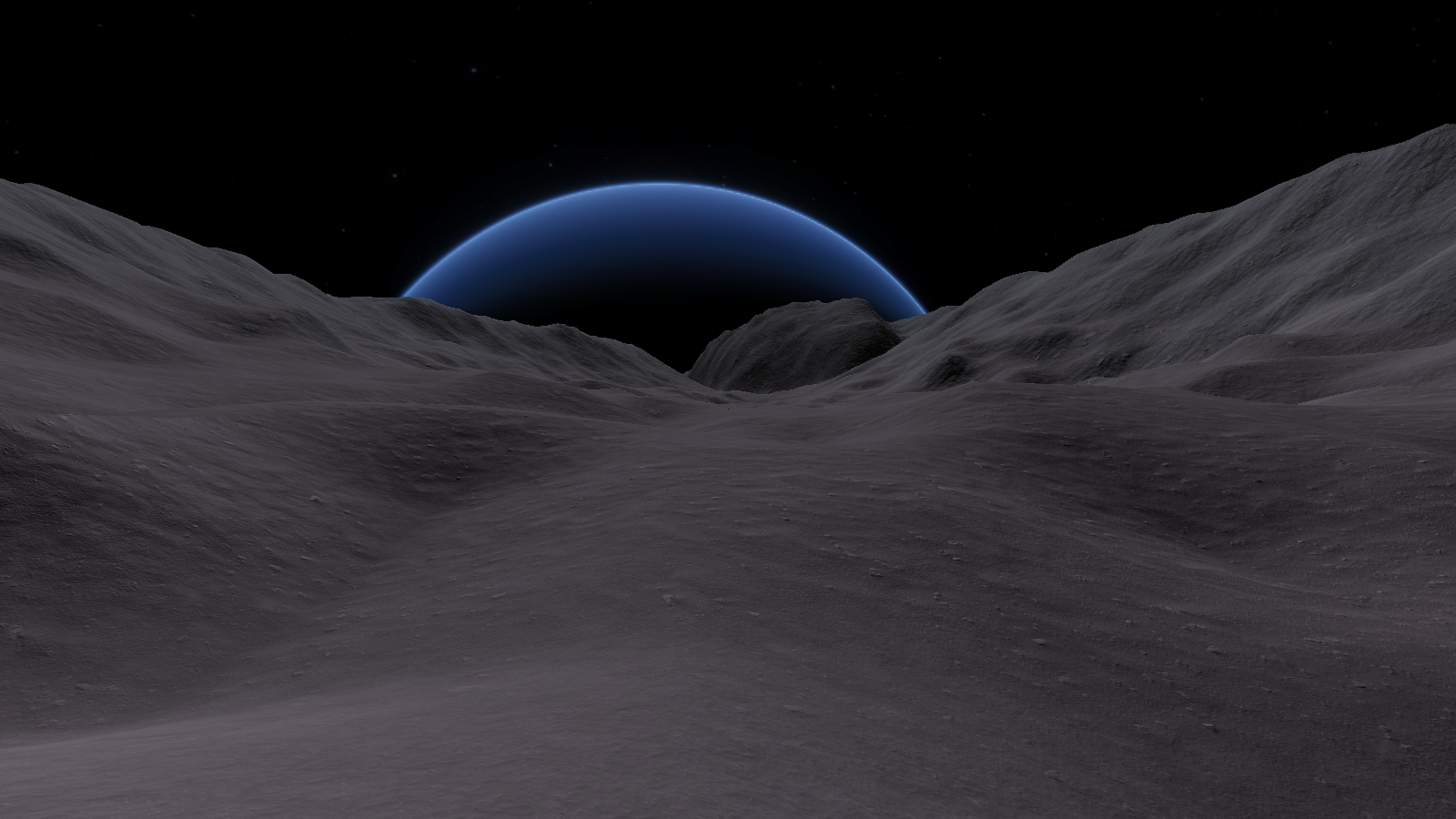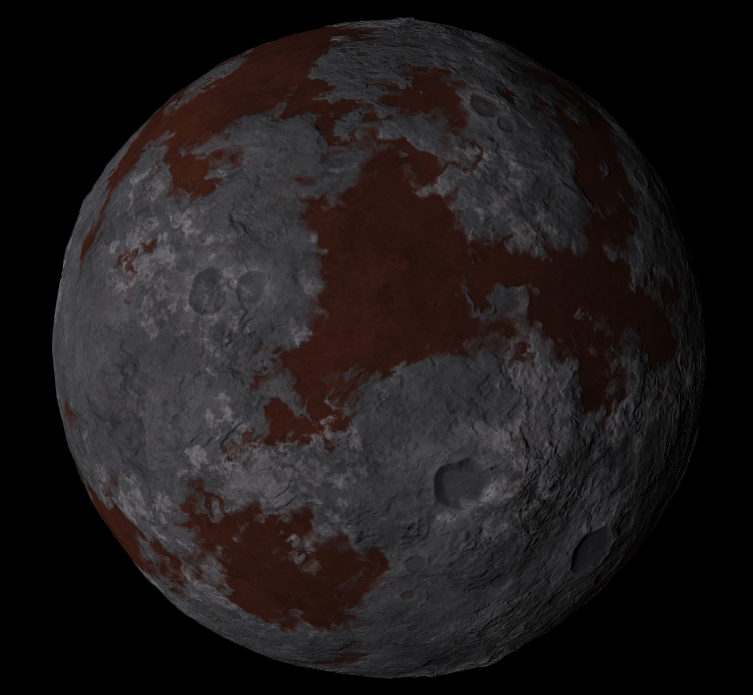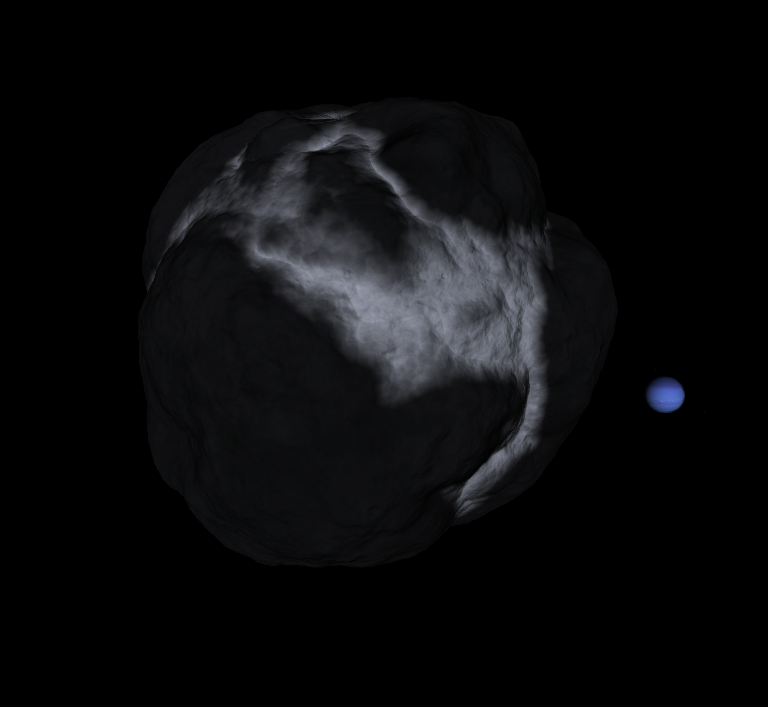The Valaya moon system
Table of contents
Mov

Mov as seen from space
Mass |
1.606E22 kg (0.21 times Moon’s) |
|---|---|
Radius |
901.12 km (0.51 times Moon’s) |
Gravity |
0.13 g |
Rotation period |
Tidally locked |
Semi-Major Axis |
87,000 km (0.22 times Moon’s) |
|---|---|
Inclination |
0° |
Eccentricity |
0.01 |
Argument of Periapsis |
350.26° |
Period |
9 h, 31 m, 4 s |
Mov is the first of Valaya’s moon, and is a small rocky world, that has been visibly ravaged by the tidal forces caused by its close proximity to the ice giant, with some of the ravines deep enough to reveal another layer in its geology. It is only barely orbiting above the roche limit, and is predicted to eventually be destroyed and turn into a ring system after another 2 - 3 million years.

Surface view from Mov
`
Mov is inspired by a moon I encountered in Elite: Dangerous that also had a lot of ravines, though that one probably not because of tidal interactions. Also, Mov is named after the x86 instruction. Don’t ask why, I don’t remember anymore.
`
Rinala

Rinala as seen from space
Mass |
2.087E22 (0.28 times Moon’s) |
|---|---|
Radius |
957.4 km (0.55 times Moon’s) |
Gravity |
0.15 g |
Rotation period |
Tidally locked |
Semi-Major Axis |
223,878.04 km |
|---|---|
Inclination |
0° |
Eccentricity |
0.03 |
Argument of Periapsis |
352.15° |
Period |
19 h, 58 m, 19 s |
Rinala is similarly affected by tidal forces as Mov, although in its case, it is superheating its inside, triggering a massive amount of volcanism on its surface, with several tall peaks on its surface being dormant volcanoes. Its yellow coloration is entirely caused by large amounts of sulphur that was brought to the surface by volcanic activity.
`
Nothing much to say here. I tried to just 1:1 copy Io for this one, to an almost embarasing degree. Of note is only that I briefly started using an Avali name generator site to get the names for a few of the celestial bodies in this system, including Rinala.
`
Ralu

Ralu as seen from space
Mass |
2.804E23 kg (3.81 times Moon’s) |
|---|---|
Radius |
2284.24 km (1.31 times Moon’s) |
Gravity |
0.36 g |
Rotation period |
Tidally locked |
Semi-Major Axis |
420,779.01 km |
|---|---|
Inclination |
0° |
Eccentricity |
0.056 |
Argument of Periapsis |
248.1° |
Period |
2 d, 3 h, 27 m, 24 s |
Being larger than Earth’s moon, Ralu is the most visible object in the Avalon night sky besides Valaya itself. The tidal interactions with Valaya have distorted its surface over millions of years, causing its warped appearance. Similar to Earth’s moon, it has several large Maria, almost flat regions of most likely volcanic origin. They have a rust-red coloration due to large amounts of tholins deposited inside them. The rest of its surface is a grey, crater-covered landscape, with an almost organic appearance when viewed from space.
`
Ralu is perfect. Its one of the most pretty objects in this system, and if you asked me, I would change absolutely nothing about it. Its also most likely the first destination someone playing the KSP mod would visit, but probably not the first they will land on. Its made to be more challenging to land on than the Mun. Char is the more obvious first destination for a landing.
`
Avalon
See Avalon
Nevu

Nevu as seen from space
Mass |
4.408E23 kg (6 times Moon’s) |
|---|---|
Radius |
2645.88 km (1.5 times Moon’s) |
Gravity |
0.42 g |
Avg. Surface Temp |
181 K (-92.15 °C) |
Atmos. pressure at datum |
0.01 atm |
Rotation period |
Tidally locked |
Semi-Major Axis |
1,205,516.6 km |
|---|---|
Inclination |
0.15 |
Longitude of Ascending Node |
0° |
Eccentricity |
0.106 |
Argument of Periapsis |
262.86° |
Period |
10 d, 9 h, 30 m, 51 s |
Nevu is the final major moon of the Valaya system. Similar to Avalon, it holds on to an atmosphere, but an incredibly thin one, which also doesn’t retain much warmth, leading to Nevu’s surface being mostly frozen. It also consists entirely of carbon dioxide, making it toxic. Still, its a good destination for early Avali colonies, due to the presence of any atmosphere whatsoever, and water ice on its surface. It surface is dominated by wide and tall ridgelines that are strangely not covered in ice, indicating ongoing geological activity.

View from above one of Nevu’s ridge lines
`
I like to call this one "mini-Mars", just because its atmosphere is basically that of Mars. I had a lot of fun making this one, and I especially enjoy the contrast between the brown ridges and icy lowlands. I remember watching The Expanse while making this one and struggling with coming up with a name for it. I ended up mis-hearing the name of the massive interstellar ship in the show when it was first shown, and so Nevu got its name.
`
Char

Char as seen from space
Mass |
4.539E16 kg |
|---|---|
Radius |
21.457 km |
Gravity |
0.00671 g |
Rotation period |
5 h, 57 m, 37 s |
Semi-Major Axis |
1,898,900.1 km |
|---|---|
Inclination |
-5.7° |
Longitude of Ascending Node |
27.89° |
Eccentricity |
0.23 |
Argument of Periapsis |
140.7° |
Period |
20 d, 13 h, 21 m, 32 s |
Char is a minor moon of Valaya, significant for its high density and unique appearance, that being its almost entirely black coloration. Its shows up particularely well in infrared, as its surface is very warm due to the black rock absorbing a lot of the light coming from Solakku. Other then that, its a medium-sized asteroid that was most likely captured by Valaya some time in the past, and happened to end up in a stable orbit.
`
I created this one to serve a particular purpose in the KSP mod, that being that it is the Minmus of the system, as in, its easy to land on. A little difficult to get to because of its high and inclined orbit, but that is offset by its almost negligible gravity, making landing and takeoff there a piece of cake.
`
`
A thing of note for this entire moon system is how I created it. I used something called a N-Body simulation, which is a simulation of celestial bodies interacting with each other through their gravities. It approximates the movement of the celestial bodies by repeatedly calculating the influences of all the graviational pulls on each celestial body, updating its acceleration and position based on that. In my case, I would start with a simulation that had a gas giant in the center, with tens of thousands of asteroid sized bodies randomly spawned in orbits around it. If two of them collided, the simulation would merge their masses, and compute the impulse of the collision as well when updating the combined body’s state vector. Running this type of simulation would always end in the asteroids acreting into a set of moons. The moon systems created through this method always feel very organic, as all the orbital resonances work out and are gravitationally stable, and the sizes and masses of the moons follow a natural progression.
In the case of Valaya, however, I had to do things a little different, due to me already having calculated the exact SMA Avalon would need to have. As a result, the simulation started with Valaya and Avalon and then the thousands of asteroids, in the hope that it would end with all the moons being in resonance with Avalon, which ended up being the case.
However, I did not use this method to generate Edith’s moon system, as I already had plans for it that required specific orbits and masses for all the moons.
`